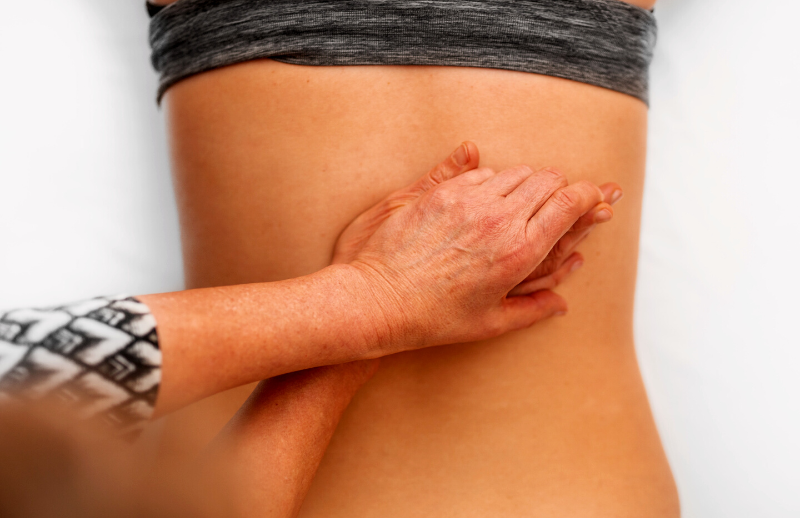
Low back pain is common and can have a detrimental impact on the ability to continue to work and your favourite activities. Despite the large impact on life, most cases of low back pain are not serious and do not require medical intervention. Even persistent and disabling chronic low back pain is not synonymous with significant tissue damage and pathology. It may seem counterintuitive, but severity of pain does not directly correlate to the severity of injury.
Recent MRI studies have shown that disc bulges, degeneration, osteophytes and other scary sounding findings are actually very common and many people have these findings on imaging but have no pain at all. In fact many of these changes may occur naturally as we age. Furthermore, we know that unnecessary x-ray and MRI among people with low back pain can lead to fear avoidance behaviours and negative coping strategies that can delay their recovery at best, and lead to poorer outcomes at worst.
Although unlikely to be serious, the specific cause of your low back pain may be complex with many factors contributing to your pain. It’s not all about injured tissues. Contrary to common belief, the degree and type of tissue injury is just one factor among many that will directly influence your pain. Moreover, if your pain has lasted longer than 3 months, factors other than tissue damage are more likely to be contributing to your pain. This is because tissue (i.e. nerve, muscle, joint, disc) healing occurs within the first few weeks to months.
Low back pain is best seen as a protective mechanism in response to your body’s perceived level of danger, threat or disruption to maintaining a balance within your body systems. Many contributing factors can have a beneficial or negative impact on the presence of your pain. This multi-factorial blend of physical factors (load management, tissue injury), psychological factors (ways of thinking about your injury, fear avoidance behaviours), social factors (stress, job demand flexibility, and home environment), lifestyle factors, among others can be involved and should be considered in treatment of your low back pain.
So what does this mean? Even in cases of severe pain, your low back pain is unlikely to need medical or surgical intervention. Treatment of your low back pain should include consideration of all potential factors contributing to your pain - not just the tissue that you have injured. Also, you are unlikely to need imaging to identify the source of your pain. In fact, this may work against you if you are responding well to physiotherapy care.
We know that a positive mindset is associated with lower levels of pain and disability. Once serious red flags are ruled out, a focus on movement within tolerable levels, graduated return to activity and exercise is recommended. Knowing the facts better prepares you to progress towards recovery. Check out these top 10 facts below:
Adapted from O’Sullivan, Caneiro, O’Sullivan, Lin, Bunzli, Wernli & O’Keefe. (2020). Back to basics: 10 facts every person should know about back pain. British Journal of Sports Medicine, 54(10), 698-699. DOI: 10.1136/bjsports-2019-101611
No referral is required to receive physiotherapy care. A clinical assessment by one of our physiotherapists will first rule out any red flags indicating serious pathology (with imaging only if necessary) followed by a physical assessment and a tailored treatment plan.
Your physiotherapist will work with you offering manual therapy to manage pain, expertise in load management and exercise prescription, assist you in developing positive coping strategies, identification of your specific contributing factors to your pain and assistance with a graduated return to doing the things you love. If required, other healthcare practitioners may be included in your treatment such as sports doctors, pain specialists or surgeons. You can expect expert advice and treatment allowing you to feel better, sooner.
Want to get started right now? General advice for people suffering from low back pain includes keeping active within tolerable limits, avoiding bed rest, using non-steroidal pain medication if required and continuing to work if possible (with job modifications if necessary).
Not sure if physiotherapy can help you? Book a complimentary 15-minute telephone consultation to discuss your specific case with a physiotherapist and receive advice on your next best move.
Are you eligible for the Careway Pathway? Careway is an escalated care pathway that ACC fully funds. If eligible, an individualized treatment plan will be devised on entry by a physiotherapist to assist you in achieving your goals. Following this, you will be connected with a team of healthcare professionals ensuring faster, coordinated care in diagnosis and delivery of treatment, facilitating a faster recovery. Your healthcare team may include sports physicians, physiotherapists, orthopaedic surgeons, vocational therapists, and pain management specialists. With no out-of-pocket costs and a connected team of health professionals, you will get the treatment you need -when you need it. Allowing you to get better, faster.
Learn more about how physiotherapy can help you with your low back pain and determine if you are eligible for the Careway pathway. Call us or book your appointment online today.
Recent Comments